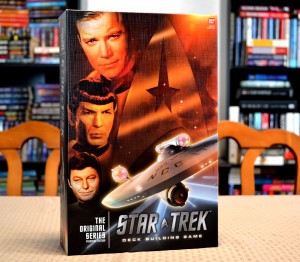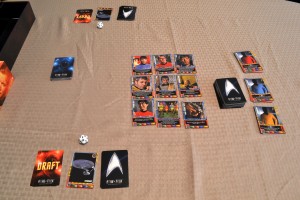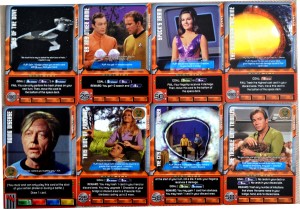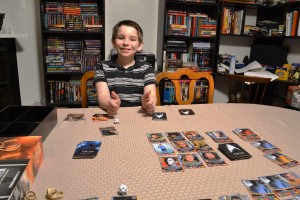“Star Trek Deck Building Game: The Original Series”, the next game from Bandai in the series, finally made its way into my household. I’d tell you to buckle your seatbelts, but for some reason they did away with those in the twenty-third century. I just chalked it up to William Shatner’s love for flinging himself across the bridge during a ship battle while conveniently ripping his tunic in the process. At any rate, this game will give players a ship, some equipment, and a very basic crew compliment. It’ll be your job to grow that crew compliment and form an unstoppable deck, capable of completing missions and events as they come up in order to reach your point goal. Let’s take a quick moment to check out the components and briefly see how the game is played before warping into the review.

Star Trek Deck Building Game: The Original Series – 2-4 Players, Ages 13+, Average Play Time = 60-90 Minutes
Components
Dice – There a four, 20-sided dice that serve as hit counters. Hit counters track the “health” of everyone’s flagship.
Starship Cards – Each player will receive a Constitution Class Starship Card of equal strength. Unlike the “Next Gen” version, there are no other ships with which to upgrade.
Starter Cards – These are the standard cards that all players receive as their initial playing deck. These consist of tricorders, hand phasers, and etc.
Basic Character Cards – These “no-names” are crewmen and officers that you pick up along the way to help you overcome challenges and perform actions. They also award XP when played on your turn, allowing you to purchase better cards. There are Ensigns, Lieutenants, and Commanders.
Starbase Cards – This set of cards makes up the largest deck. They are a combination of maneuvers, setups, and unique characters. Players will be “purchasing” these cards with XP so that they can be added to their individual playing decks. They will assist players in a variety of ways.
Draft Cards – New to this series, these Draft Cards are duplicates of the standard fifteen purple mission cards. Players receive a few at the beginning of the game and can complete them for points.
Standard Exploration Scenario Cards – Included in this scenario deck, if doing the Standard Exploration Scenario, are twenty-five unique mission / event cards. The card identifier tab is colored yellow to set these cards apart from the rest.
Infection Exploration Scenario Cards – Included in this scenario deck, if doing the Infection Scenario, are twenty-five unique mission / event cards. There’s also an Infection deck (another twenty-five cards), which players will draw from during the game. The card identifier tab is colored orange to set these cards apart from the rest.
Setup
1. Each player starts with the same ten cards, forming their starting deck. (Five Starter Cards and five Basic Characters)
2. Players will seed the Space Deck. The Space Deck is a combination of the universal purple mission cards and the cards that are appropriate for the scenario that they’ve chosen to play (either yellow or orange). If opting for the Infection Scenario, the Infection deck is placed near the Space Deck.
3. All Starbase Cards are shuffled and then nine are drawn in a 3×3 grid. This will be the available pool in which players can “purchase” characters, manuevers, and setups from.
4. The Basic Character Cards are sorted and placed near the Starbase Cards.
5. Each person receives a hit counter die, the starting value equal to their starter ship’s Defense value. They also receive three Draft Cards, though they’ll only keep two.
6. All players draw five cards from their deck.
Gameplay
The goal of both scenarios is to gain a certain number of goal or victory points (300 by default), which are earned as players complete missions from the Space Deck. Missions and events require stat checks, so players will need to build up their personal deck in order to tackle them properly.
On a player’s turn, they’ll play some or all of the cards in their hand onto their bridge (or active zone). For that turn only, these cards and their effects will be considered when the player goes to perform actions. Some cards grant XP, which is used to purchase new cards from the 3 x 3 Starbase pool. Some cards grant bonuses to particular stats, allowing players to pass stat checks and complete missions. Players can opt to repair their ship or perform search / explore actions, which simply involves players drawing a new card from either the Starbase Deck or Space Deck and replacing an existing card.
Once a player is done with their turn, they’ll discard (not trash) those cards and draw five new ones. If a player’s deck runs out, they’ll shuffle their discard pile and start anew. The process simply repeats around the table until one player manages to complete enough missions to where their victory point pool exceeds a certain value. Keep in mind that the above doesn’t cover all of the rules found in the manual, but hi-lights the basics enough to where it’ll give you an idea as to how the gameplay flows. Normally I’d link the manual, but the official Bandai site appears to be down as all of the links in my “Next Gen” review appear to be broken. If you have questions, feel free to leave a comment below.
The Review
Being an avid Star Trek fan, I have a hard time disliking most things related to the genre. Call me biased if you like…there’s just something about the series as a whole that appeals to my inner science geek. This particular game plays a lot like the “Next Gen” version, which I reviewed here. For those of you who don’t have the time to check said review out, it was a solid “Trek” experience, albeit a confusing one. The manual made things more complicated than they needed to be, but I still enjoyed my time with it as a whole. “Star Trek Deck Building Game: The Original Series”, thankfully, doesn’t change the formula all that much. In fact, I simply copy and pasted some of the above content from my “Next Gen” review into this article…they are that similar.
This actually saved me a lot of frustration. The manual in this particular game was equally as confusing, though my experience with “Next Gen” helped me out considerably. I had no issues diving right in and it didn’t take much for me to figure out how everything came together. Everything, for the most part, is set up and played exactly the same way…everything down to the 3 x 3 Starbase pool. The separate Infection cards behave very similarly to the Borg cards in that they are drawn and seeded into a player’s personal deck to debuff them in various ways. I thought it was odd that the “upgrade your ship” mechanic was left out of this game, but I found that it helped to keep players on equal footing throughout the entire game.
As far as theme goes, “Star Trek Deck Building Game: The Original Series” has plenty of it. I was both surprised and puzzled by the inclusion of the mirror universe cards. Having two Kirks, two Spocks, two Scottys, and etc. admittedly felt weird but gratifying at the same time. Like the “Next Gen” game, there are a lot of Trek references that will make fans of the genre happy. I recognized all of the characters that appeared and, being a Trek fan, had to resist the urge to place every single one of them into my deck. For those of you new to the deck building genre…larger doesn’t always mean better. It’s more efficient to consistently draw very useful cards every turn as opposed to drawing a lot of trash cards that really don’t serve a purpose. Luckily, you can give up taking actions on a turn in place of trashing a card from your hand.
If I had to choose one game over the other (“Next Gen” or “TOS”), I’d honestly have to go with “Next Gen”. It offers three scenarios as opposed to “TOS’s” two, and allows folks to upgrade their ships. In essence, “Next Gen” offers slightly more. That’s not to say that “Star Trek Deck Building Game: The Original Series” is a bad game…it’s most certainly a joy to play. I almost giggle with childlike glee every time I see the “Doomsday Machine” card pop up…even if the art used is based on the remastered version instead of the original. The box was a tad on the big side considering that it only needed to hold two-hundred plus cards, though this is a minor complaint. You can grab this game for under twenty bucks (as of 9/26/13) on Amazon, which isn’t a bad deal by any means. It wouldn’t be my first choice as an introductory game to the genre as the learning curve is a bit steep, but it’s relatively enjoyable once you get the hang of it.
Final Verdict: 7/10
—




if s card reads “if user has a cost of 5+, you may trash this card” (This is on the Hand Phaser card). Does this mean the user of the phaser must cost 5 OR MORE xp’s? Or MORE THAN % xp’s?